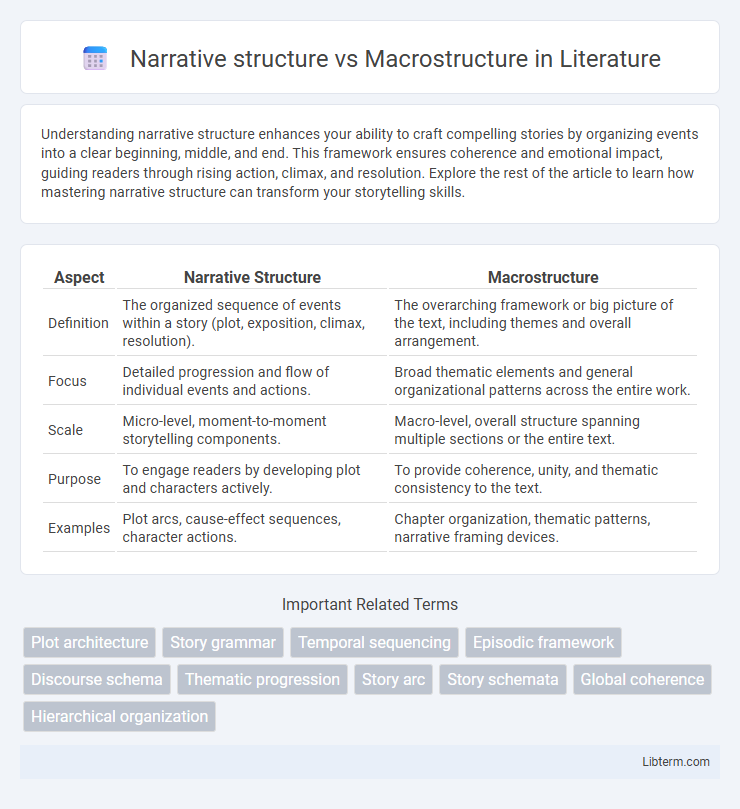Understanding narrative structure enhances your ability to craft compelling stories by organizing events into a clear beginning, middle, and end. This framework ensures coherence and emotional impact, guiding readers through rising action, climax, and resolution. Explore the rest of the article to learn how mastering narrative structure can transform your storytelling skills.
Table of Comparison
| Aspect | Narrative Structure | Macrostructure |
|---|---|---|
| Definition | The organized sequence of events within a story (plot, exposition, climax, resolution). | The overarching framework or big picture of the text, including themes and overall arrangement. |
| Focus | Detailed progression and flow of individual events and actions. | Broad thematic elements and general organizational patterns across the entire work. |
| Scale | Micro-level, moment-to-moment storytelling components. | Macro-level, overall structure spanning multiple sections or the entire text. |
| Purpose | To engage readers by developing plot and characters actively. | To provide coherence, unity, and thematic consistency to the text. |
| Examples | Plot arcs, cause-effect sequences, character actions. | Chapter organization, thematic patterns, narrative framing devices. |
Introduction to Narrative Structure and Macrostructure
Narrative structure refers to the organized framework of a story, encompassing elements like plot, setting, characters, and conflict, which guide how a narrative unfolds from beginning to end. Macrostructure involves the overarching thematic and conceptual patterns that shape the entire narrative, providing coherence and meaning across various story elements. Understanding both narrative structure and macrostructure is essential for analyzing how stories are constructed and how their larger meanings are conveyed.
Defining Narrative Structure
Narrative structure refers to the organized framework through which a story unfolds, encompassing elements such as plot, characters, setting, conflict, and resolution. Unlike macrostructure, which deals with the overall theme and general storyline, narrative structure emphasizes the specific sequence and causality of events that shape the reader's experience. Defining narrative structure involves understanding its components like exposition, rising action, climax, falling action, and denouement to create coherent and engaging storytelling.
Understanding Macrostructure in Literature
Macrostructure in literature refers to the overarching framework that organizes the main ideas and themes within a narrative, contrasting with narrative structure, which deals with how events unfold sequentially. Understanding macrostructure involves analyzing the global coherence and the hierarchical arrangement of information that shapes the interpretation of a text. This broader perspective helps readers grasp the author's intended message, thematic development, and conceptual relationships beyond individual plot elements.
Key Differences Between Narrative Structure and Macrostructure
Narrative structure refers to the specific arrangement of events and elements within a story, including plot, characters, and settings, which guides the reader through the sequence of actions and experiences. Macrostructure encompasses the overall organization and thematic framework of a text, focusing on broader patterns like the main idea, overarching themes, and structural hierarchy. The key difference lies in scale and focus: narrative structure addresses the detailed progression of events, while macrostructure emphasizes the global coherence and conceptual organization of the entire discourse.
Functions of Narrative Structure in Storytelling
Narrative structure organizes the sequence of events within a story, guiding the audience through exposition, rising action, climax, and resolution to create emotional engagement and coherence. It functions to establish character motivations, build tension, and ensure thematic development, which drives the story's progression and audience investment. Macrostructure, by contrast, refers to the overarching framework or global meaning of the story, encompassing plot, setting, and overarching themes rather than moment-to-moment event sequencing.
Roles of Macrostructure in Text Organization
Macrostructure plays a crucial role in text organization by providing a coherent framework that guides the overall flow and thematic development of the narrative. It helps in structuring the main ideas and key events, enabling readers to grasp the broader context and progression within the text. By establishing a hierarchical arrangement of concepts and events, macrostructure enhances comprehension and retention of complex information in both written and spoken discourse.
Narrative Structure Elements: Plot, Character, Setting
Narrative structure elements, including plot, character, and setting, form the foundational components that organize a story's events and experiences into a coherent sequence. The plot drives the narrative through a series of conflicts and resolutions, while characters provide perspective and emotional depth that engage the audience. The setting establishes the time and place, creating context that influences the mood and development of both the plot and characters, distinguishing it from the broader macrostructure, which encompasses the overall thematic and organizational framework of the narrative.
Macrostructure Components: Cohesion, Coherence, Thematic Progression
Macrostructure in narrative analysis encompasses cohesion, coherence, and thematic progression as its core components, ensuring the overall unity and clarity of a text. Cohesion refers to the linguistic elements that connect sentences and ideas, such as conjunctions, pronouns, and lexical ties, creating a seamless flow. Coherence involves the logical organization and meaningful connections between parts of the text, while thematic progression tracks how themes evolve and develop throughout the narrative, guiding readers through the intended message or story arc.
Interplay Between Narrative Structure and Macrostructure
Narrative structure refers to the specific organization of events and scenes within a story, including elements like plot, character development, and temporal flow. Macrostructure encompasses the overarching framework or global coherence that connects multiple narratives or thematic units across a larger text or discourse. The interplay between narrative structure and macrostructure is crucial for creating cohesive storytelling, as well-constructed micro-level sequences support the broader macro-level themes, ensuring that individual plot points collectively reinforce the narrative's global meaning and purpose.
Implications for Writers and Literary Analysis
Narrative structure defines the specific sequence and organization of events within a story, while macrostructure encompasses the overarching framework and thematic patterns across the entire narrative. Writers must balance detailed plot development with coherent macrostructural elements to enhance thematic depth and maintain reader engagement. Literary analysis benefits from distinguishing these levels by examining how micro-level narrative choices influence broader macrostructural meanings and themes.
Narrative structure Infographic

 libterm.com
libterm.com